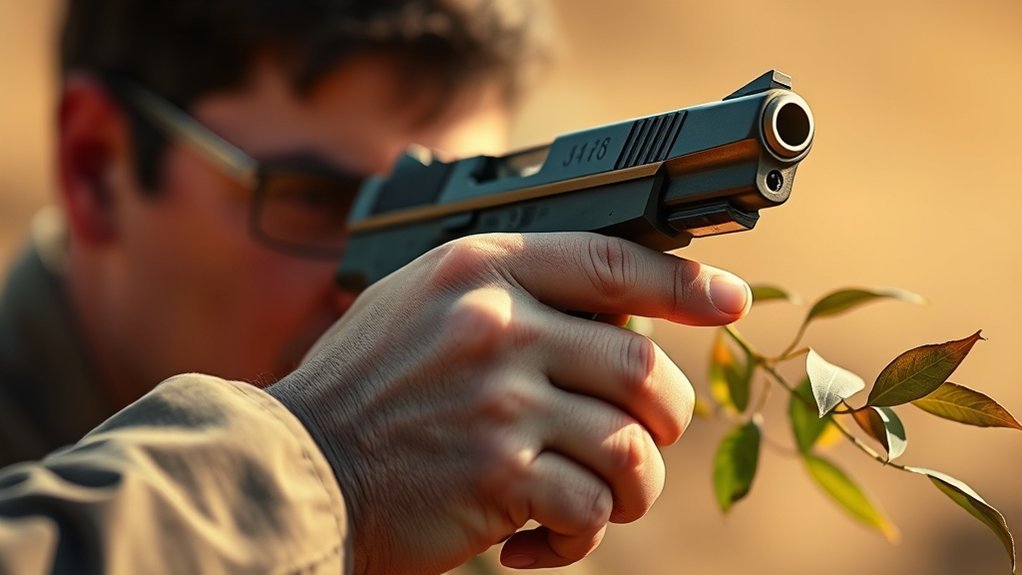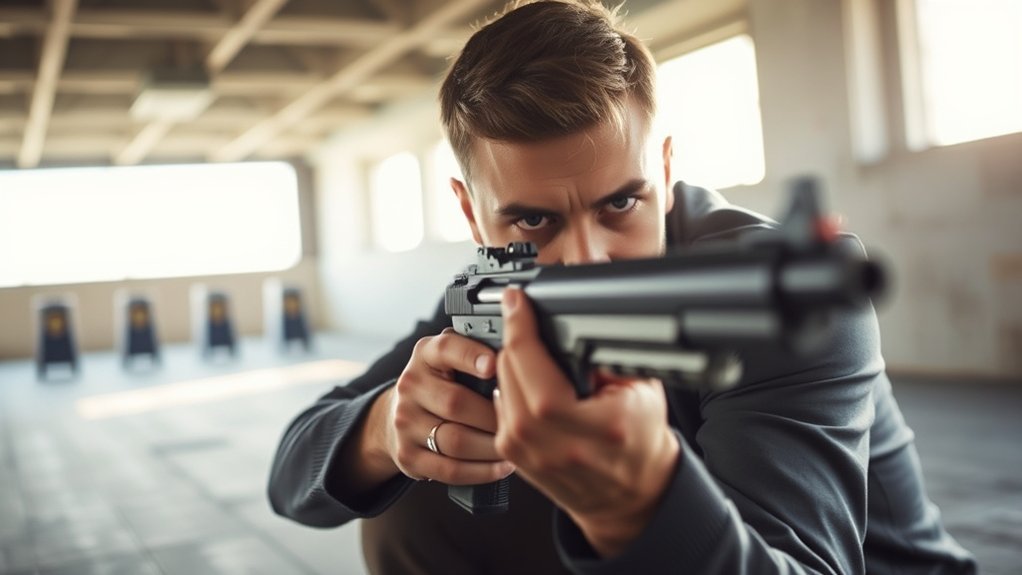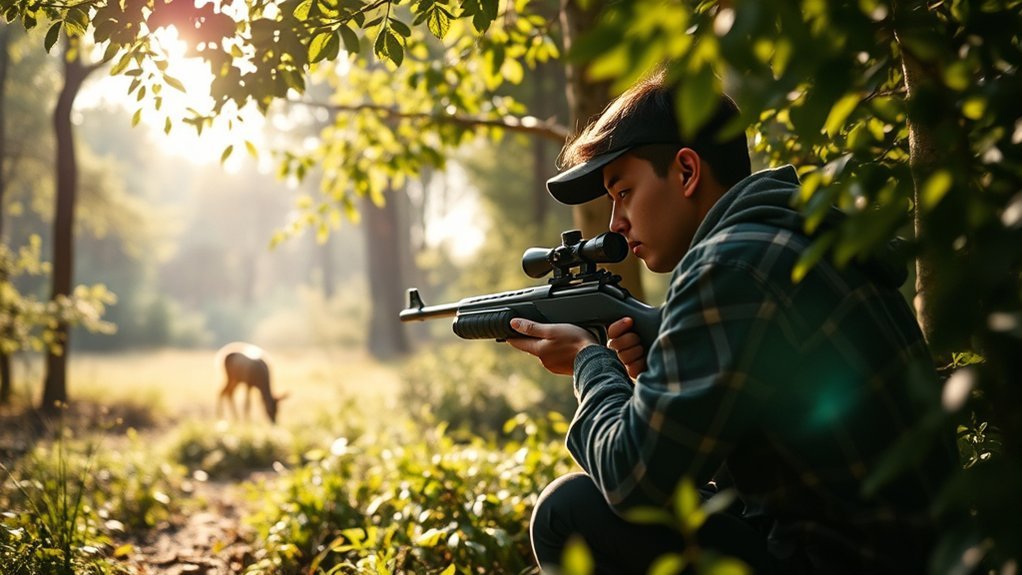Many shooters overlook the critical role that breath control plays in achieving precision. By mastering your breathing, you can greatly improve your stability and focus, which are essential for accurate shooting. However, breath control alone isn’t enough; it must be paired with effective trigger discipline to prevent unnecessary movements. Understanding how these two concepts interact can elevate your shooting performance to a new level. So, how do you integrate these skills into your practice routine effectively?
Understanding Breath Control

When it comes to shooting accuracy, mastering breath control is essential. Controlling your breath helps stabilize your body and reduces movement when you aim. Start by taking a deep breath, filling your lungs completely, then exhale slowly until you reach a comfortable level. As you aim, pause briefly at the end of your exhale—this is typically when your body is most stable. Avoid holding your breath too long, as it can lead to tension and shaky hands. Practice this technique consistently to develop muscle memory, enhancing your shooting performance over time. Remember, breath control isn’t just about timing; it’s about finding your rhythm and maintaining focus, ensuring each shot is deliberate and accurate.
The Importance of Trigger Discipline

Breath control lays the groundwork for accurate shooting, but trigger discipline is what guarantees each shot counts. When you pull the trigger, you need to do it deliberately and with intention. This means avoiding any unnecessary movements that can disrupt your aim. Proper trigger discipline involves keeping your finger off the trigger until you’re ready to fire, ensuring you don’t accidentally discharge the weapon. It also requires a smooth, controlled squeeze rather than a jerky motion, which can throw off your shot. By maintaining trigger discipline, you enhance your accuracy and minimize the risk of unintended discharges. Remember, every shot should be a conscious decision, reinforcing the importance of this critical skill in shooting fundamentals.
Techniques for Effective Breath Control

Effective breath control relies on mastering diaphragmatic breathing techniques and implementing breath timing strategies. By focusing on your diaphragm, you can enhance your lung capacity and improve stability during critical moments. Additionally, synchronizing your breath with your actions can markedly reduce anxiety and enhance your overall performance.
Diaphragmatic Breathing Techniques
Many individuals overlook the importance of proper breathing techniques in achieving ideal control and focus. Diaphragmatic breathing, or abdominal breathing, is vital for maximizing breath control. To practice, find a comfortable position, either sitting or lying down. Place one hand on your chest and the other on your abdomen. Inhale deeply through your nose, ensuring your abdomen rises while your chest remains relatively still. This engages your diaphragm, allowing for more efficient oxygen intake. Exhale slowly through your mouth, feeling your abdomen fall. Repeat this process several times to build muscle memory. Incorporating diaphragmatic breathing into your routine helps reduce stress, enhances concentration, and ultimately improves your overall performance, whether in shooting or other precision activities.
Breath Timing Strategies
When aiming for precision in activities like shooting, mastering breath timing is essential for maintaining focus and stability. Effective breath control helps you avoid unnecessary movement and enhances accuracy. Here are three key strategies to improve your breath timing:
- Inhale Deeply: Take a deep breath before you prepare to shoot. This oxygen boost calms your nerves and stabilizes your body.
- Pause at the Top: Hold your breath briefly after inhaling. This moment of stillness allows for better control while you aim.
- Exhale Slowly: As you prepare to squeeze the trigger, exhale gently. This process keeps your body relaxed and steady, reducing the chance of movement.
Implementing these strategies will greatly enhance your performance and precision in any shooting scenario.
Building Trigger Discipline Through Practice
To build trigger discipline, you need to incorporate focused breathing techniques into your practice routine. Engage in slow and steady exercises that promote control and precision with your trigger finger. Mindful trigger control drills will further enhance your ability to maintain discipline under pressure.
Focused Breathing Techniques
Focused breathing techniques are essential for enhancing trigger discipline, as they help you maintain calm and control under pressure. By integrating these techniques into your practice, you can improve your focus and reduce anxiety when handling firearms. Here are three effective methods to incorporate:
- Diaphragmatic Breathing: Breathe deeply from your diaphragm, allowing your abdomen to expand. This promotes relaxation and oxygenates your body efficiently.
- Controlled Exhalation: Exhale slowly through pursed lips. This not only calms your nerves but also aids in steadying your aim.
- Rhythmic Breathing: Establish a consistent breathing pattern, such as inhaling for four counts and exhaling for four counts. This helps synchronize your body and mind, enhancing overall performance.
Implementing these techniques will greatly contribute to your trigger discipline.
Slow and Steady Practice
While mastering trigger discipline requires dedication, slow and steady practice is key to developing the necessary skills. Begin by establishing a consistent routine, focusing on controlled movements and deliberate actions. Use a dry-fire practice setup to eliminate the distractions of live ammunition. This approach allows you to concentrate solely on your trigger control. Gradually increase the complexity of your drills, incorporating varied scenarios and distances. Pay attention to your grip and finger placement, ensuring that you only engage the trigger when you’re ready to shoot. Consistent repetition reinforces muscle memory, enabling you to react instinctively under pressure. Remember, quality practice is more beneficial than quantity; prioritize precision over speed to foster lasting trigger discipline.
Mindful Trigger Control Exercises
Building on the foundation of slow and steady practice, incorporating mindful trigger control exercises can greatly enhance your skills. These exercises help you develop better discipline and precision, essential for effective shooting. Here are three key exercises to implement:
- Dry Firing: Practice pulling the trigger on an empty chamber, focusing on smoothness and consistency without disturbing your sights.
- Breath Control: Combine breath control techniques with trigger pulls, ensuring you pull the trigger during the natural respiratory pause.
- Controlled Pair Drills: Fire two rounds in quick succession while maintaining trigger discipline, focusing on your grip and follow-through.
The Connection Between Breath Control and Accuracy
Breath control plays an essential role in enhancing shooting accuracy, as it directly influences your body’s stability and focus. When you control your breathing, you minimize movement in your upper body, allowing for a steadier aim. Each breath cycle offers an opportunity to align your sights with your target; exhaling gently as you prepare to shoot helps create a natural pause. This pause reduces the physiological stress that can cause involuntary muscle contractions, leading to better trigger discipline. Additionally, maintaining a calm breathing rhythm keeps your heart rate steady, which can prevent shaky hands. By mastering breath control, you’ll enhance your ability to shoot consistently and accurately, ultimately improving your overall performance.
Common Mistakes in Breath Control and Trigger Discipline
Often, shooters overlook fundamental aspects of breath control and trigger discipline, leading to diminished performance. By understanding common mistakes, you can enhance your shooting skills effectively. Here are three critical errors to avoid:
- Holding Your Breath: Many believe pausing breath enhances stability, but it can increase tension and affect your shot.
- Jerking the Trigger: Anticipating the shot can lead to a jerky pull. Focus on a smooth, consistent press instead.
- Inconsistent Breathing Patterns: Irregular breathing can disrupt your rhythm. Establish a steady pattern to maintain focus.
Recognizing these mistakes can greatly improve your accuracy and overall shooting technique. By correcting them, you’ll build a stronger foundation for precision shooting.
Drills to Enhance Breath Control and Trigger Discipline
To enhance your breath control and trigger discipline, incorporating targeted drills into your practice routine is essential. Start with the “5-Count Drill.” Inhale for five seconds, hold for five, exhale for five, and pause for five before repeating. This drill builds breath control under pressure. Next, practice “Dry Fire Drills.” Set up a target, focus on your sight picture, and pull the trigger without live ammunition. Concentrate on your breathing as you squeeze the trigger, ensuring a smooth and steady action. You can also try the “Controlled Breathing Drill” while engaging in shooting stances. Each time you press the trigger, synchronize your breath to create consistency. Regularly practicing these drills will greatly improve your overall performance.
Real-World Applications of These Skills
While you might train in controlled environments, the real-world applications of breath control and trigger discipline are critical for effective shooting in dynamic situations. Mastering these skills can greatly enhance your performance in various scenarios, such as:
- Self-Defense: In high-stress encounters, maintaining steady breath control helps you manage anxiety and focus on your target.
- Hunting: Accurate shots in unpredictable environments require trigger discipline, ensuring you only fire when conditions align perfectly.
- Competitive Shooting: Consistent breath control and precise trigger pulls can be the difference between winning and losing, as every shot counts.
Integrating Breath Control and Trigger Discipline Into Training
Integrating breath control and trigger discipline into your training regimen is essential for developing effective shooting habits. Start by practicing breath control during dry-fire drills; take a deep breath, exhale slowly, and squeeze the trigger at the natural pause of your breath. This helps minimize movement and enhances focus.
Next, incorporate trigger discipline by emphasizing the importance of a smooth, controlled trigger pull. Use visual and tactile feedback, such as a shot timer or a laser training device, to reinforce proper timing and pressure.
Finally, simulate high-stress scenarios to practice maintaining both skills under pressure. Consistent application of these techniques will improve your accuracy and overall shooting performance, ensuring you’re prepared for real-world situations.
Conclusion
Incorporating breath control and trigger discipline into your shooting practice can be a game-changer. As you refine these skills, the difference in your accuracy will become evident. But what happens when you face high-pressure situations? Will your training hold up? The answer lies in consistent practice and understanding the nuances of each technique. Master these elements, and you’ll not only improve your shooting but also gain the confidence to tackle any scenario that comes your way.

